belt BMW 535I GRAN TURISMO 2014 Owners Manual
[x] Cancel search | Manufacturer: BMW, Model Year: 2014, Model line: 535I GRAN TURISMO, Model: BMW 535I GRAN TURISMO 2014Pages: 251, PDF Size: 7.64 MB
Page 9 of 251
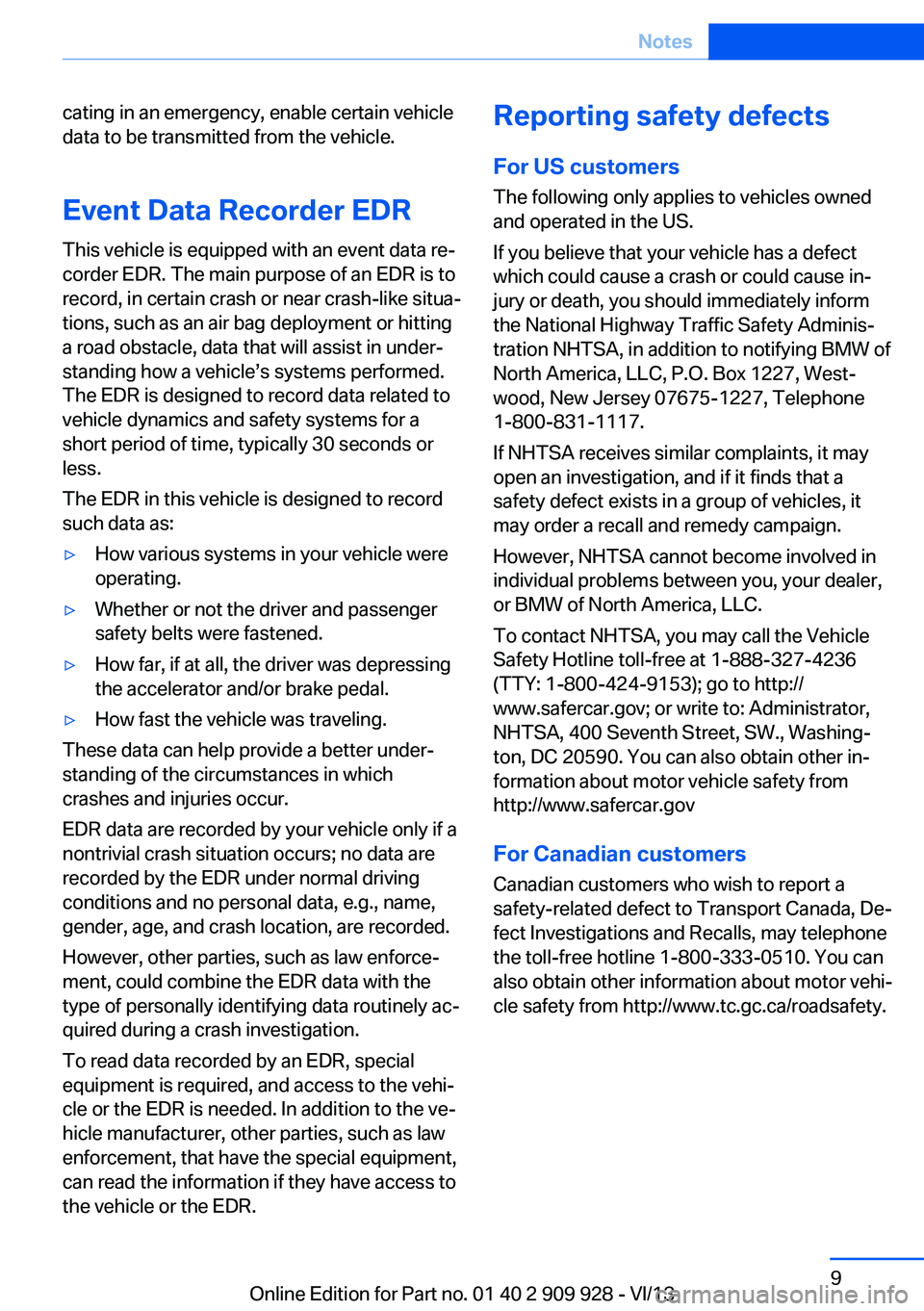
cating in an emergency, enable certain vehicle
data to be transmitted from the vehicle.
Event Data Recorder EDR
This vehicle is equipped with an event data reâ
corder EDR. The main purpose of an EDR is to
record, in certain crash or near crash-like situaâ
tions, such as an air bag deployment or hitting
a road obstacle, data that will assist in underâ
standing how a vehicleâs systems performed.
The EDR is designed to record data related to
vehicle dynamics and safety systems for a
short period of time, typically 30 seconds or
less.
The EDR in this vehicle is designed to record
such data as:âˇHow various systems in your vehicle were
operating.âˇWhether or not the driver and passenger
safety belts were fastened.âˇHow far, if at all, the driver was depressing
the accelerator and/or brake pedal.âˇHow fast the vehicle was traveling.
These data can help provide a better underâ
standing of the circumstances in which
crashes and injuries occur.
EDR data are recorded by your vehicle only if a
nontrivial crash situation occurs; no data are
recorded by the EDR under normal driving
conditions and no personal data, e.g., name,
gender, age, and crash location, are recorded.
However, other parties, such as law enforceâ
ment, could combine the EDR data with the
type of personally identifying data routinely acâ
quired during a crash investigation.
To read data recorded by an EDR, special
equipment is required, and access to the vehiâ
cle or the EDR is needed. In addition to the veâ
hicle manufacturer, other parties, such as law
enforcement, that have the special equipment,
can read the information if they have access to
the vehicle or the EDR.
Reporting safety defects
For US customers
The following only applies to vehicles owned
and operated in the US.
If you believe that your vehicle has a defect
which could cause a crash or could cause inâ
jury or death, you should immediately inform
the National Highway Traffic Safety Adminisâ
tration NHTSA, in addition to notifying BMW of
North America, LLC, P.O. Box 1227, Westâ
wood, New Jersey 07675-1227, Telephone
1-800-831-1117.
If NHTSA receives similar complaints, it may
open an investigation, and if it finds that a
safety defect exists in a group of vehicles, it
may order a recall and remedy campaign.
However, NHTSA cannot become involved in
individual problems between you, your dealer,
or BMW of North America, LLC.
To contact NHTSA, you may call the Vehicle
Safety Hotline toll-free at 1-888-327-4236
(TTY: 1-800-424-9153); go to http://
www.safercar.gov; or write to: Administrator,
NHTSA, 400 Seventh Street, SW., Washingâ
ton, DC 20590. You can also obtain other inâ
formation about motor vehicle safety from
http://www.safercar.gov
For Canadian customers Canadian customers who wish to report a
safety-related defect to Transport Canada, Deâ
fect Investigations and Recalls, may telephone
the toll-free hotline 1-800-333-0510. You can
also obtain other information about motor vehiâ
cle safety from http://www.tc.gc.ca/roadsafety.Seite 9Notes9
Online Edition for Part no. 01 40 2 909 928 - VI/13
Page 49 of 251
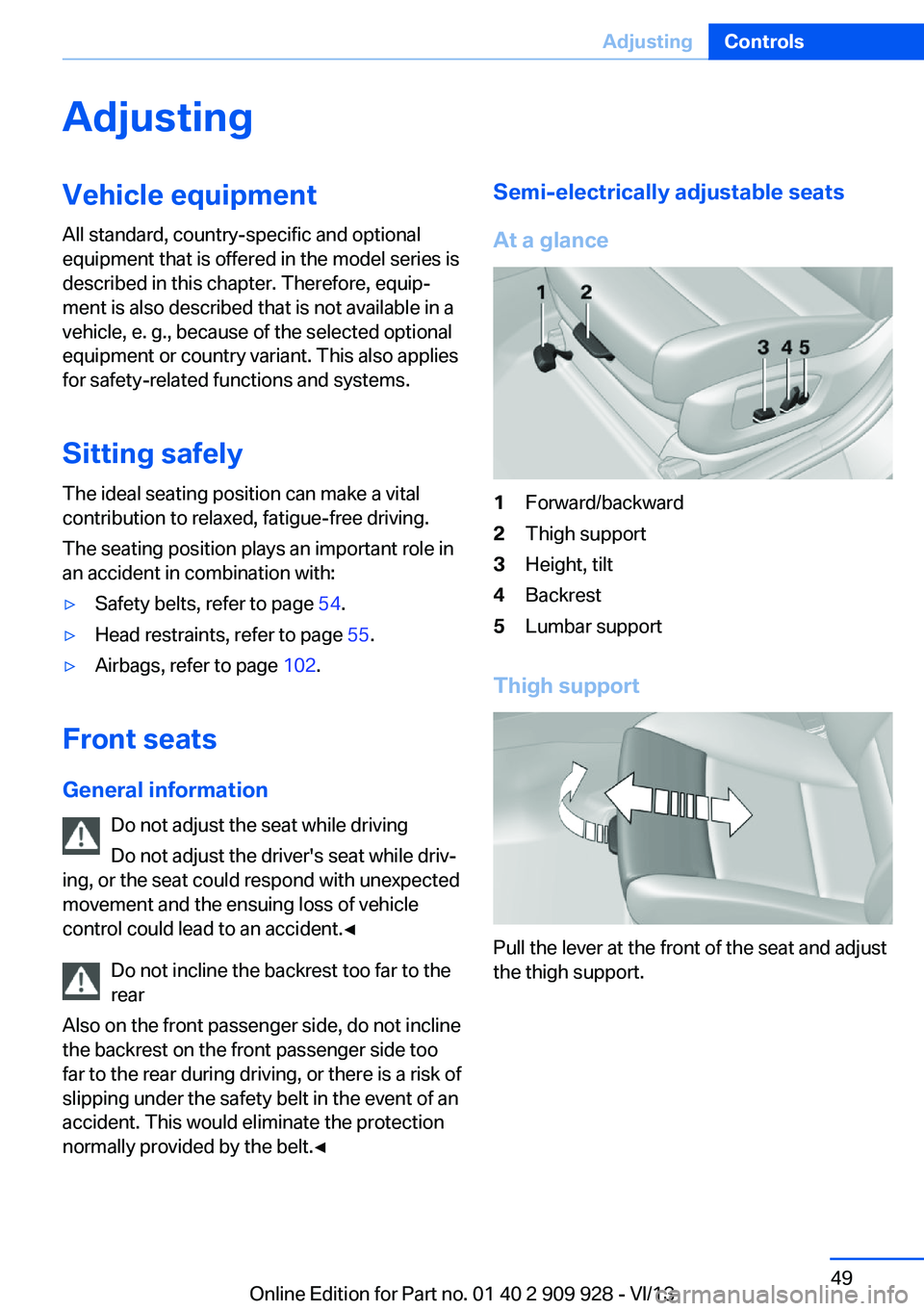
AdjustingVehicle equipment
All standard, country-specific and optional
equipment that is offered in the model series is
described in this chapter. Therefore, equipâ
ment is also described that is not available in a
vehicle, e. g., because of the selected optional
equipment or country variant. This also applies
for safety-related functions and systems.
Sitting safely The ideal seating position can make a vital
contribution to relaxed, fatigue-free driving.
The seating position plays an important role in
an accident in combination with:âˇSafety belts, refer to page 54.âˇHead restraints, refer to page 55.âˇAirbags, refer to page 102.
Front seats
General information Do not adjust the seat while driving
Do not adjust the driver's seat while drivâ
ing, or the seat could respond with unexpected
movement and the ensuing loss of vehicle
control could lead to an accident.â
Do not incline the backrest too far to the
rear
Also on the front passenger side, do not incline
the backrest on the front passenger side too far to the rear during driving, or there is a risk of
slipping under the safety belt in the event of an
accident. This would eliminate the protection
normally provided by the belt.â
Semi-electrically adjustable seats
At a glance1Forward/backward2Thigh support3Height, tilt4Backrest5Lumbar support
Thigh support
Pull the lever at the front of the seat and adjust
the thigh support.
Seite 49AdjustingControls49
Online Edition for Part no. 01 40 2 909 928 - VI/13
Page 54 of 251
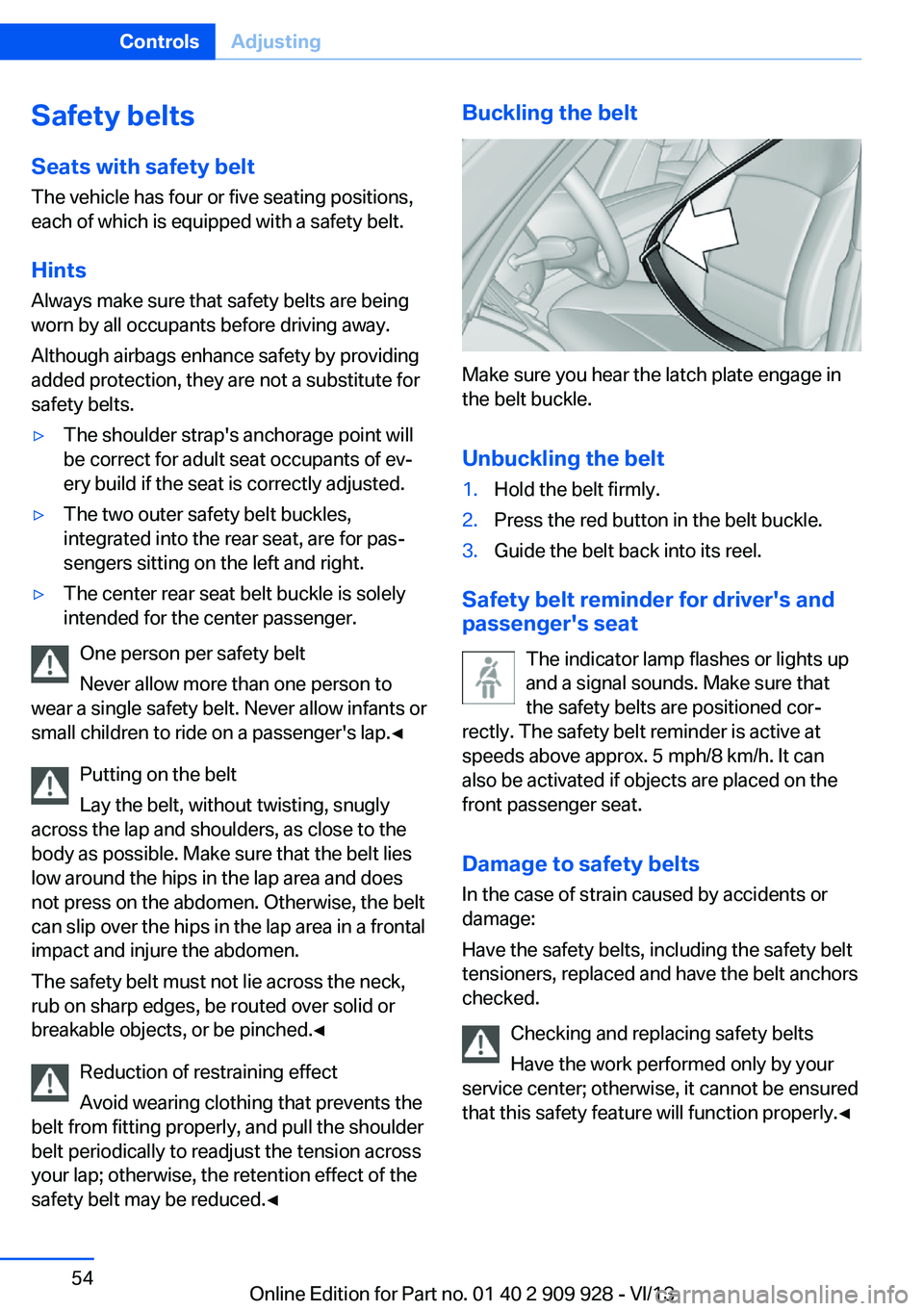
Safety beltsSeats with safety belt
The vehicle has four or five seating positions,
each of which is equipped with a safety belt.
Hints Always make sure that safety belts are being
worn by all occupants before driving away.
Although airbags enhance safety by providing
added protection, they are not a substitute for
safety belts.âˇThe shoulder strap's anchorage point will
be correct for adult seat occupants of evâ
ery build if the seat is correctly adjusted.âˇThe two outer safety belt buckles,
integrated into the rear seat, are for pasâ
sengers sitting on the left and right.âˇThe center rear seat belt buckle is solely
intended for the center passenger.
One person per safety belt
Never allow more than one person to
wear a single safety belt. Never allow infants or
small children to ride on a passenger's lap.â
Putting on the belt
Lay the belt, without twisting, snugly
across the lap and shoulders, as close to the
body as possible. Make sure that the belt lies
low around the hips in the lap area and does
not press on the abdomen. Otherwise, the belt
can slip over the hips in the lap area in a frontal
impact and injure the abdomen.
The safety belt must not lie across the neck,
rub on sharp edges, be routed over solid or
breakable objects, or be pinched.â
Reduction of restraining effect
Avoid wearing clothing that prevents the
belt from fitting properly, and pull the shoulder
belt periodically to readjust the tension across
your lap; otherwise, the retention effect of the
safety belt may be reduced.â
Buckling the belt
Make sure you hear the latch plate engage in
the belt buckle.
Unbuckling the belt
1.Hold the belt firmly.2.Press the red button in the belt buckle.3.Guide the belt back into its reel.
Safety belt reminder for driver's and
passenger's seat
The indicator lamp flashes or lights up
and a signal sounds. Make sure that
the safety belts are positioned corâ
rectly. The safety belt reminder is active at
speeds above approx. 5 mph/8 km/h. It can
also be activated if objects are placed on the
front passenger seat.
Damage to safety belts In the case of strain caused by accidents or
damage:
Have the safety belts, including the safety belt
tensioners, replaced and have the belt anchors checked.
Checking and replacing safety belts
Have the work performed only by your
service center; otherwise, it cannot be ensured
that this safety feature will function properly.â
Seite 54ControlsAdjusting54
Online Edition for Part no. 01 40 2 909 928 - VI/13
Page 61 of 251
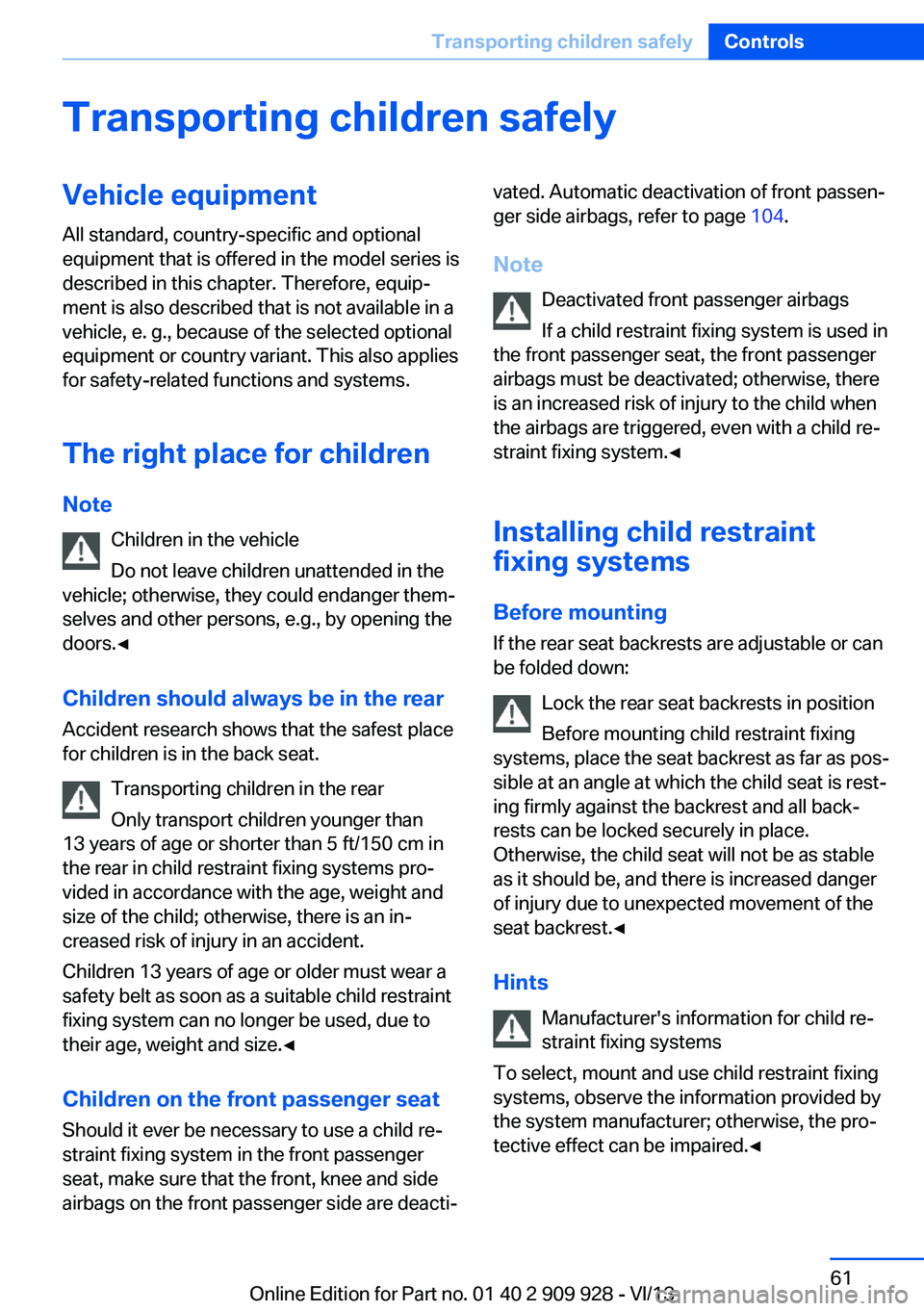
Transporting children safelyVehicle equipmentAll standard, country-specific and optional
equipment that is offered in the model series is
described in this chapter. Therefore, equipâ
ment is also described that is not available in a
vehicle, e. g., because of the selected optional
equipment or country variant. This also applies
for safety-related functions and systems.
The right place for children Note Children in the vehicle
Do not leave children unattended in the
vehicle; otherwise, they could endanger themâ
selves and other persons, e.g., by opening the
doors.â
Children should always be in the rear
Accident research shows that the safest place
for children is in the back seat.
Transporting children in the rear
Only transport children younger than
13 years of age or shorter than 5 ft/150 cm in
the rear in child restraint fixing systems proâ
vided in accordance with the age, weight and
size of the child; otherwise, there is an inâ
creased risk of injury in an accident.
Children 13 years of age or older must wear a
safety belt as soon as a suitable child restraint
fixing system can no longer be used, due to
their age, weight and size.â
Children on the front passenger seat
Should it ever be necessary to use a child reâ
straint fixing system in the front passenger
seat, make sure that the front, knee and side
airbags on the front passenger side are deactiâvated. Automatic deactivation of front passenâ
ger side airbags, refer to page 104.
Note Deactivated front passenger airbags
If a child restraint fixing system is used in
the front passenger seat, the front passenger
airbags must be deactivated; otherwise, there
is an increased risk of injury to the child when
the airbags are triggered, even with a child reâ
straint fixing system.â
Installing child restraint
fixing systems
Before mounting
If the rear seat backrests are adjustable or can
be folded down:
Lock the rear seat backrests in position
Before mounting child restraint fixing
systems, place the seat backrest as far as posâ
sible at an angle at which the child seat is restâ
ing firmly against the backrest and all backâ
rests can be locked securely in place.
Otherwise, the child seat will not be as stable
as it should be, and there is increased danger
of injury due to unexpected movement of the
seat backrest.â
Hints Manufacturer's information for child reâ
straint fixing systems
To select, mount and use child restraint fixing
systems, observe the information provided by
the system manufacturer; otherwise, the proâ
tective effect can be impaired.âSeite 61Transporting children safelyControls61
Online Edition for Part no. 01 40 2 909 928 - VI/13
Page 62 of 251
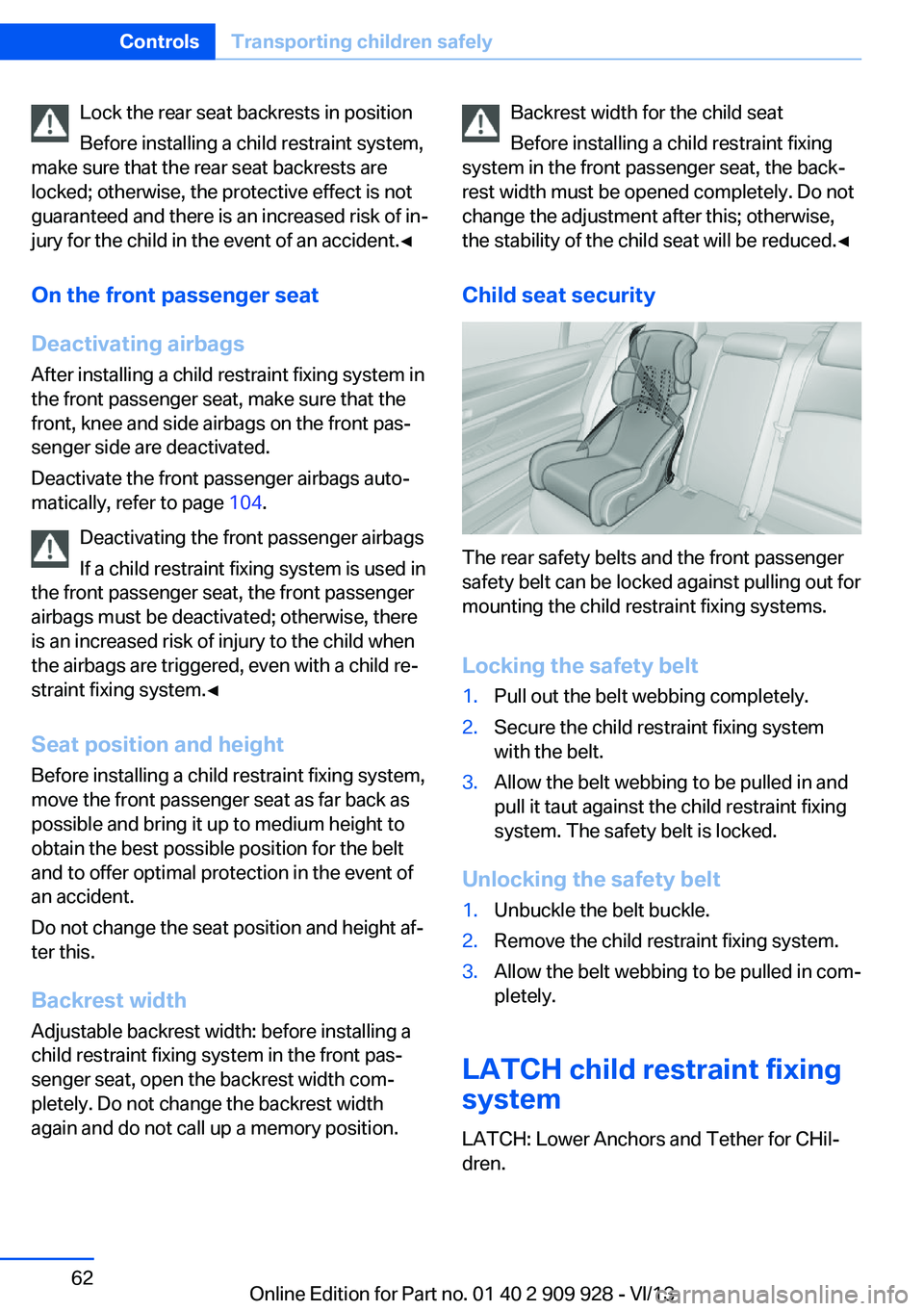
Lock the rear seat backrests in position
Before installing a child restraint system,
make sure that the rear seat backrests are
locked; otherwise, the protective effect is not
guaranteed and there is an increased risk of inâ
jury for the child in the event of an accident.â
On the front passenger seat
Deactivating airbags
After installing a child restraint fixing system in
the front passenger seat, make sure that the
front, knee and side airbags on the front pasâ
senger side are deactivated.
Deactivate the front passenger airbags autoâ
matically, refer to page 104.
Deactivating the front passenger airbags
If a child restraint fixing system is used in
the front passenger seat, the front passenger
airbags must be deactivated; otherwise, there
is an increased risk of injury to the child when
the airbags are triggered, even with a child reâ
straint fixing system.â
Seat position and height
Before installing a child restraint fixing system,
move the front passenger seat as far back as
possible and bring it up to medium height to
obtain the best possible position for the belt
and to offer optimal protection in the event of
an accident.
Do not change the seat position and height afâ
ter this.
Backrest width Adjustable backrest width: before installing a
child restraint fixing system in the front pasâ
senger seat, open the backrest width comâ
pletely. Do not change the backrest width
again and do not call up a memory position.Backrest width for the child seat
Before installing a child restraint fixing
system in the front passenger seat, the backâ
rest width must be opened completely. Do not
change the adjustment after this; otherwise,
the stability of the child seat will be reduced.â
Child seat security
The rear safety belts and the front passenger
safety belt can be locked against pulling out for
mounting the child restraint fixing systems.
Locking the safety belt
1.Pull out the belt webbing completely.2.Secure the child restraint fixing system
with the belt.3.Allow the belt webbing to be pulled in and
pull it taut against the child restraint fixing
system. The safety belt is locked.
Unlocking the safety belt
1.Unbuckle the belt buckle.2.Remove the child restraint fixing system.3.Allow the belt webbing to be pulled in comâ
pletely.
LATCH child restraint fixing
system
LATCH: Lower Anchors and Tether for CHilâdren.
Seite 62ControlsTransporting children safely62
Online Edition for Part no. 01 40 2 909 928 - VI/13
Page 63 of 251
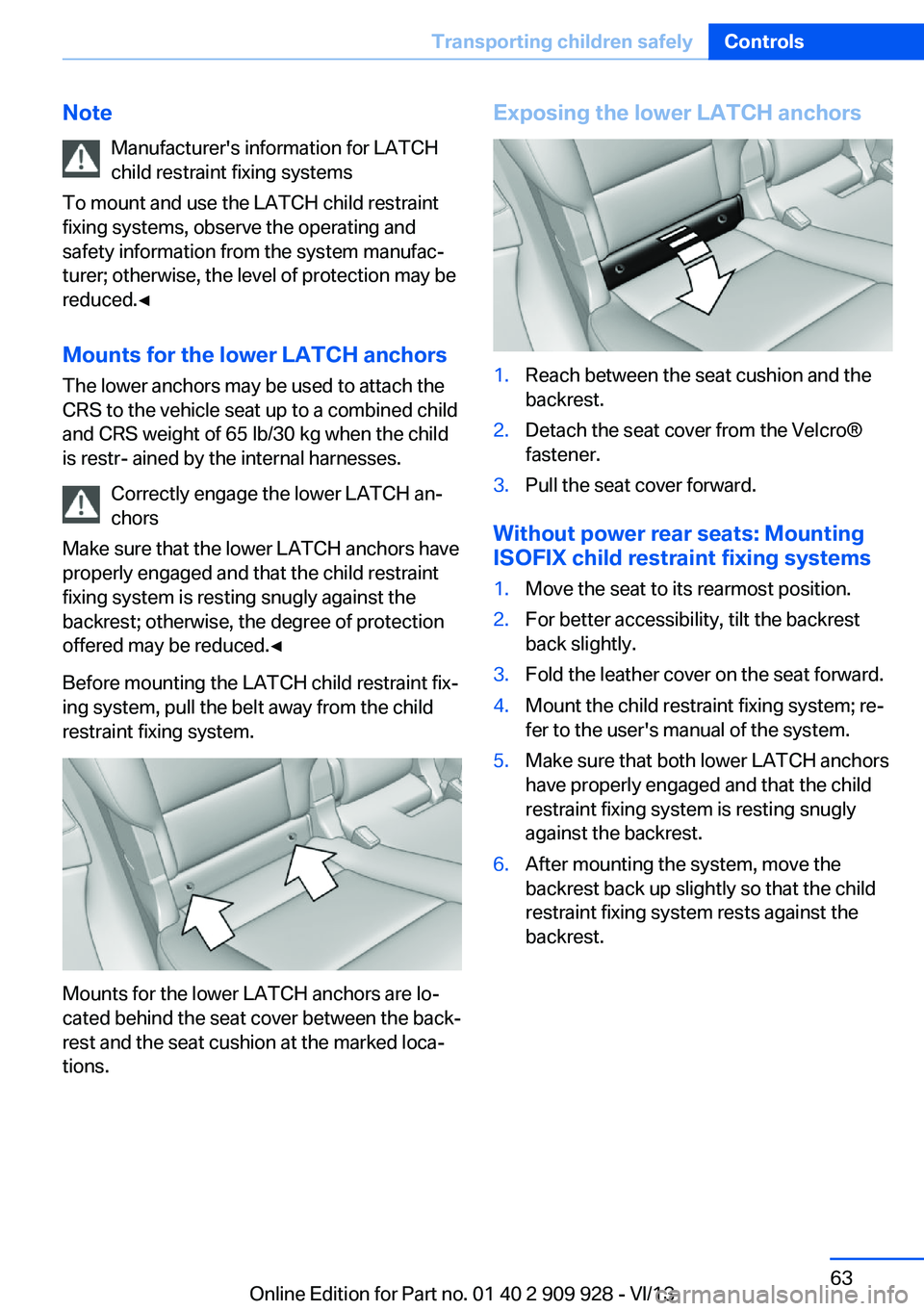
NoteManufacturer's information for LATCHchild restraint fixing systems
To mount and use the LATCH child restraint
fixing systems, observe the operating and
safety information from the system manufacâ
turer; otherwise, the level of protection may be
reduced.â
Mounts for the lower LATCH anchors
The lower anchors may be used to attach the
CRS to the vehicle seat up to a combined child
and CRS weight of 65 lb/30 kg when the child
is restr- ained by the internal harnesses.
Correctly engage the lower LATCH anâ
chors
Make sure that the lower LATCH anchors have
properly engaged and that the child restraint
fixing system is resting snugly against the
backrest; otherwise, the degree of protection
offered may be reduced.â
Before mounting the LATCH child restraint fixâ
ing system, pull the belt away from the child
restraint fixing system.
Mounts for the lower LATCH anchors are loâ
cated behind the seat cover between the backâ
rest and the seat cushion at the marked locaâ
tions.
Exposing the lower LATCH anchors1.Reach between the seat cushion and the
backrest.2.Detach the seat cover from the VelcroÂŽ
fastener.3.Pull the seat cover forward.
Without power rear seats: Mounting ISOFIX child restraint fixing systems
1.Move the seat to its rearmost position.2.For better accessibility, tilt the backrest
back slightly.3.Fold the leather cover on the seat forward.4.Mount the child restraint fixing system; reâ
fer to the user's manual of the system.5.Make sure that both lower LATCH anchors
have properly engaged and that the child
restraint fixing system is resting snugly
against the backrest.6.After mounting the system, move the
backrest back up slightly so that the child
restraint fixing system rests against the
backrest.Seite 63Transporting children safelyControls63
Online Edition for Part no. 01 40 2 909 928 - VI/13
Page 64 of 251
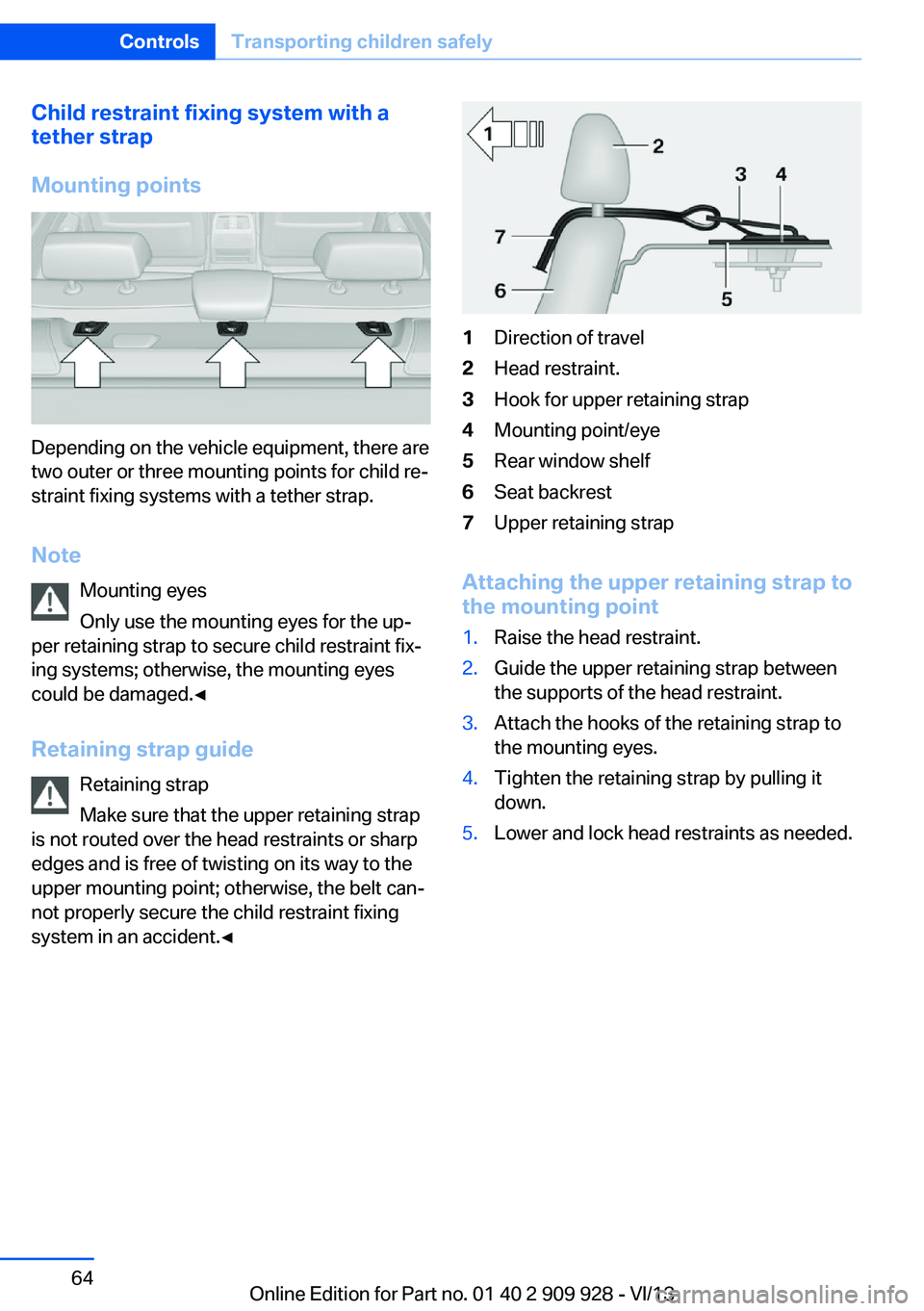
Child restraint fixing system with a
tether strap
Mounting points
Depending on the vehicle equipment, there are
two outer or three mounting points for child reâ
straint fixing systems with a tether strap.
Note Mounting eyes
Only use the mounting eyes for the upâ
per retaining strap to secure child restraint fixâ
ing systems; otherwise, the mounting eyes
could be damaged.â
Retaining strap guide Retaining strap
Make sure that the upper retaining strap
is not routed over the head restraints or sharp
edges and is free of twisting on its way to the
upper mounting point; otherwise, the belt canâ
not properly secure the child restraint fixing
system in an accident.â
1Direction of travel2Head restraint.3Hook for upper retaining strap4Mounting point/eye5Rear window shelf6Seat backrest7Upper retaining strap
Attaching the upper retaining strap to
the mounting point
1.Raise the head restraint.2.Guide the upper retaining strap between
the supports of the head restraint.3.Attach the hooks of the retaining strap to
the mounting eyes.4.Tighten the retaining strap by pulling it
down.5.Lower and lock head restraints as needed.Seite 64ControlsTransporting children safely64
Online Edition for Part no. 01 40 2 909 928 - VI/13
Page 65 of 251
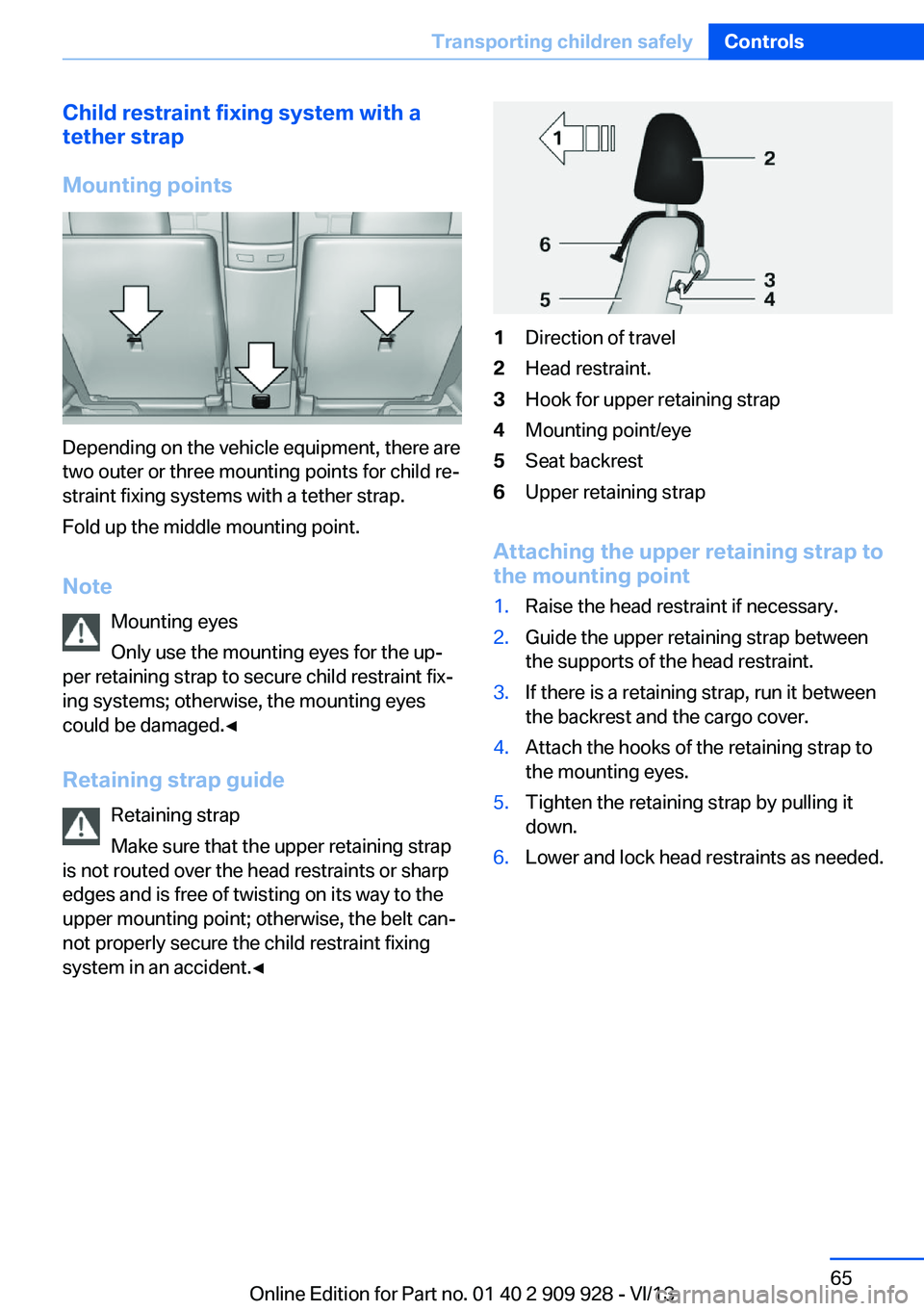
Child restraint fixing system with a
tether strap
Mounting points
Depending on the vehicle equipment, there are
two outer or three mounting points for child reâ
straint fixing systems with a tether strap.
Fold up the middle mounting point.
Note Mounting eyes
Only use the mounting eyes for the upâ
per retaining strap to secure child restraint fixâ
ing systems; otherwise, the mounting eyes
could be damaged.â
Retaining strap guide Retaining strap
Make sure that the upper retaining strap
is not routed over the head restraints or sharp
edges and is free of twisting on its way to the
upper mounting point; otherwise, the belt canâ
not properly secure the child restraint fixing
system in an accident.â
1Direction of travel2Head restraint.3Hook for upper retaining strap4Mounting point/eye5Seat backrest6Upper retaining strap
Attaching the upper retaining strap to
the mounting point
1.Raise the head restraint if necessary.2.Guide the upper retaining strap between
the supports of the head restraint.3.If there is a retaining strap, run it between
the backrest and the cargo cover.4.Attach the hooks of the retaining strap to
the mounting eyes.5.Tighten the retaining strap by pulling it
down.6.Lower and lock head restraints as needed.Seite 65Transporting children safelyControls65
Online Edition for Part no. 01 40 2 909 928 - VI/13
Page 67 of 251
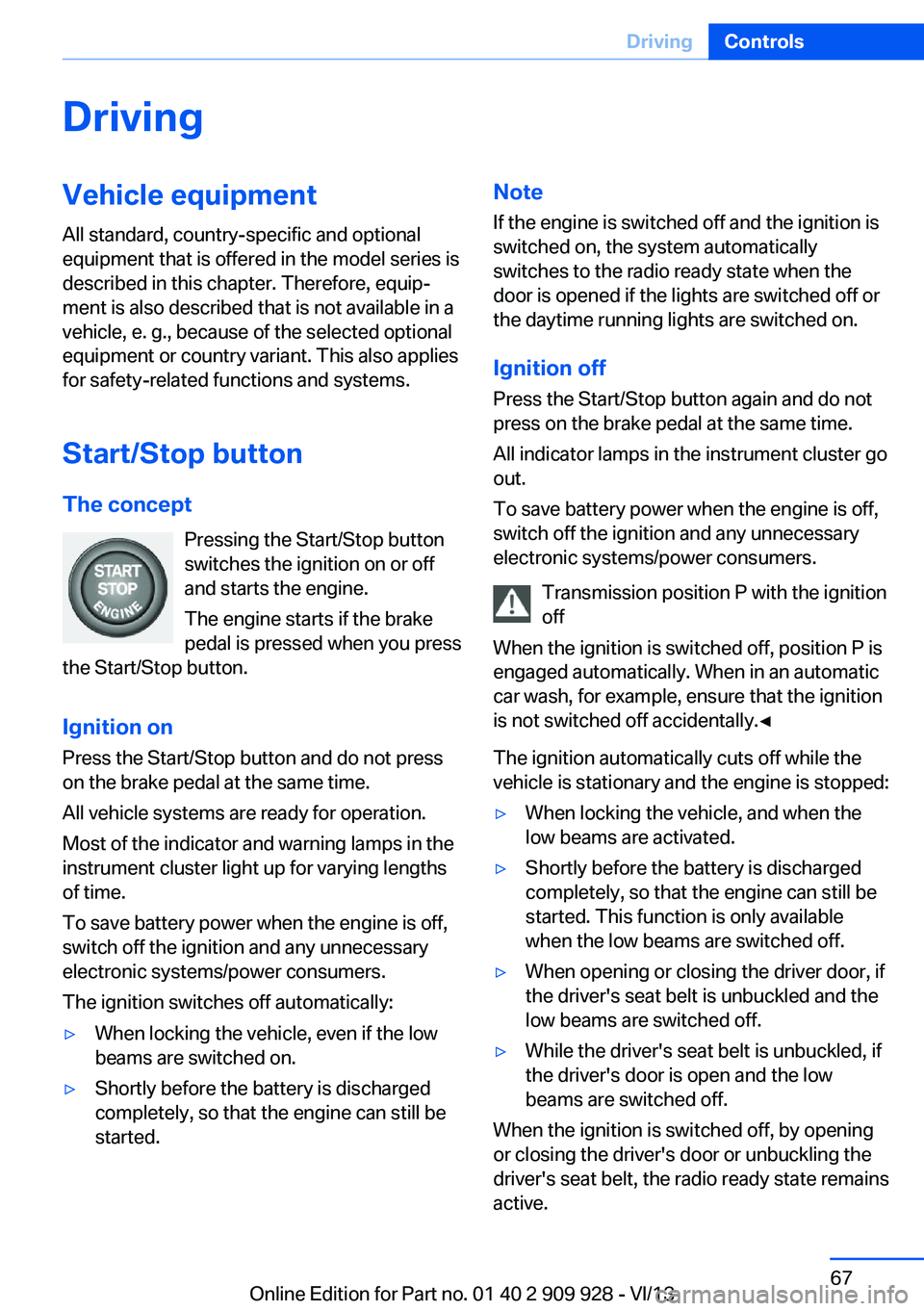
DrivingVehicle equipment
All standard, country-specific and optional
equipment that is offered in the model series is
described in this chapter. Therefore, equipâ
ment is also described that is not available in a
vehicle, e. g., because of the selected optional
equipment or country variant. This also applies
for safety-related functions and systems.
Start/Stop button The concept Pressing the Start/Stop button
switches the ignition on or off
and starts the engine.
The engine starts if the brake
pedal is pressed when you press
the Start/Stop button.
Ignition onPress the Start/Stop button and do not press
on the brake pedal at the same time.
All vehicle systems are ready for operation.
Most of the indicator and warning lamps in the
instrument cluster light up for varying lengths
of time.
To save battery power when the engine is off,
switch off the ignition and any unnecessary
electronic systems/power consumers.
The ignition switches off automatically:âˇWhen locking the vehicle, even if the low
beams are switched on.âˇShortly before the battery is discharged
completely, so that the engine can still be
started.Note
If the engine is switched off and the ignition is
switched on, the system automatically
switches to the radio ready state when the
door is opened if the lights are switched off or
the daytime running lights are switched on.
Ignition off
Press the Start/Stop button again and do not
press on the brake pedal at the same time.
All indicator lamps in the instrument cluster go
out.
To save battery power when the engine is off,
switch off the ignition and any unnecessary
electronic systems/power consumers.
Transmission position P with the ignition
off
When the ignition is switched off, position P is
engaged automatically. When in an automatic
car wash, for example, ensure that the ignition
is not switched off accidentally.â
The ignition automatically cuts off while the
vehicle is stationary and the engine is stopped:âˇWhen locking the vehicle, and when the
low beams are activated.âˇShortly before the battery is discharged
completely, so that the engine can still be
started. This function is only available
when the low beams are switched off.âˇWhen opening or closing the driver door, if
the driver's seat belt is unbuckled and the
low beams are switched off.âˇWhile the driver's seat belt is unbuckled, if
the driver's door is open and the low
beams are switched off.
When the ignition is switched off, by opening
or closing the driver's door or unbuckling the
driver's seat belt, the radio ready state remains
active.
Seite 67DrivingControls67
Online Edition for Part no. 01 40 2 909 928 - VI/13
Page 69 of 251
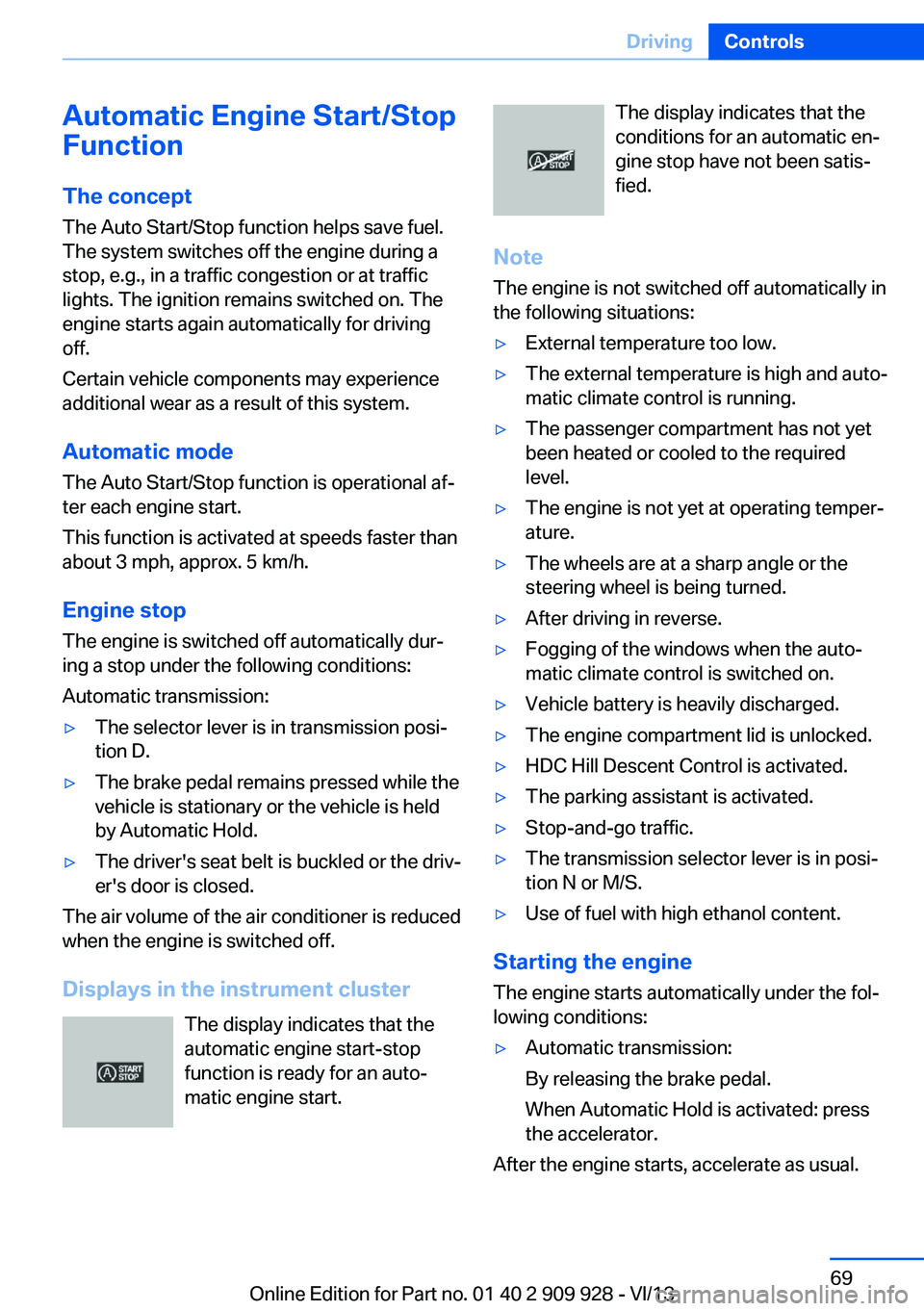
Automatic Engine Start/Stop
Function
The concept The Auto Start/Stop function helps save fuel.
The system switches off the engine during a
stop, e.g., in a traffic congestion or at traffic
lights. The ignition remains switched on. The
engine starts again automatically for driving
off.
Certain vehicle components may experience
additional wear as a result of this system.
Automatic mode
The Auto Start/Stop function is operational afâ
ter each engine start.
This function is activated at speeds faster than
about 3 mph, approx. 5 km/h.
Engine stop
The engine is switched off automatically durâ
ing a stop under the following conditions:
Automatic transmission:âˇThe selector lever is in transmission posiâ
tion D.âˇThe brake pedal remains pressed while the
vehicle is stationary or the vehicle is held
by Automatic Hold.âˇThe driver's seat belt is buckled or the drivâ
er's door is closed.
The air volume of the air conditioner is reduced
when the engine is switched off.
Displays in the instrument cluster The display indicates that the
automatic engine start-stop
function is ready for an autoâ
matic engine start.
The display indicates that the
conditions for an automatic enâ
gine stop have not been satisâ
fied.
Note
The engine is not switched off automatically in
the following situations:âˇExternal temperature too low.âˇThe external temperature is high and autoâ
matic climate control is running.âˇThe passenger compartment has not yet
been heated or cooled to the required
level.âˇThe engine is not yet at operating temperâ
ature.âˇThe wheels are at a sharp angle or the
steering wheel is being turned.âˇAfter driving in reverse.âˇFogging of the windows when the autoâ
matic climate control is switched on.âˇVehicle battery is heavily discharged.âˇThe engine compartment lid is unlocked.âˇHDC Hill Descent Control is activated.âˇThe parking assistant is activated.âˇStop-and-go traffic.âˇThe transmission selector lever is in posiâ
tion N or M/S.âˇUse of fuel with high ethanol content.
Starting the engine
The engine starts automatically under the folâ
lowing conditions:
âˇAutomatic transmission:
By releasing the brake pedal.
When Automatic Hold is activated: press
the accelerator.
After the engine starts, accelerate as usual.
Seite 69DrivingControls69
Online Edition for Part no. 01 40 2 909 928 - VI/13